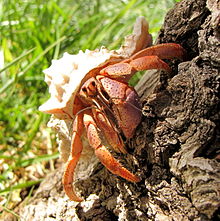- Caribbean hermit crab
-
Caribbean hermit crab Scientific classification Kingdom: Animalia Phylum: Arthropoda Subphylum: Crustacea Order: Decapoda Family: Coenobitidae Genus: Coenobita Species: C. clypeatus Binomial name Coenobita clypeatus
(Fabricius, 1787)[1]The Caribbean hermit crab, Coenobita clypeatus, also known as the soldier crab,[2] the West Atlantic crab, the tree crab, and the purple pincher (due to the distinctive purple claw), is a species of land hermit crab native to the west Atlantic, Bahamas, Belize, southern Florida,[3] Venezuela, the Virgin Islands, and the West Indies.[4] Adults burrow and hide under the roots of large trees, and can be found a considerable distance inland.[3]
Caribbean hermit crabs are both herbivorous and scavengers. In the wild, C. clypeatus feeds on animal and plant remains, overripe fruit, and feces of other animals,[3] including the Mona ground iguana, Cyclura stejnegeri.[2] The West Indian top snail (Cittarium pica) shell is often used for its home, and the hermit crab can use its larger claw to cover the aperture of the shell for protection against predators.[3] Female land hermit crabs release fertilized eggs into the ocean. The spawning (called "washing" in the English-speaking Caribbean) occurs on certain nights, usually around August.[2]
This species is one of the two land hermit crabs commonly sold in the United States as a pet, the other being the Ecuadorian hermit crab.[4][5]
References
- ^ Patsy A. McLaughlin, Tomoyuki Komai, Rafael Lemaitre & Dwi Listyo Rahayu (2010). Part I – Lithodoidea, Lomisoidea and Paguroidea. In Martyn E. Y. Low and S. H. Tan. "Annotated checklist of anomuran decapod crustaceans of the world (exclusive of the Kiwaoidea and families Chirostylidae and Galatheidae of the Galatheoidea)" (PDF). Zootaxa Suppl. 23: 5–107. http://rmbr.nus.edu.sg/rbz/biblio/s23/s23rbz005-107.pdf.
- ^ a b c Ángel M. Nieves-Rivera & Ernest H. Williams, Jr. (2003). "Annual migrations and spawning of Coenobita clypeatus (Herbst) on Mona Island (Puerto Rico) and notes on inland crustaceans". Crustaceana 76 (5): 547–558. doi:10.1163/156854003322316191. JSTOR 20105594.
- ^ a b c d "Common Coastal Flora and Fauna of Vieques". National Oceanic and Atmospheric Administration. http://mapping2.orr.noaa.gov/portal/vieques/pdfs/VCHTbook.pdf. Retrieved July 14, 2009.
- ^ a b Audrey Pavia (2006). "What is a hermit crab?". Hermit Crab. Volume 51 of Your Happy Healthy Pet (2nd ed.). John Wiley and Sons. pp. 13–22. ISBN 9780471793793. http://books.google.com/books?id=FlYGxERCosEC&pg=PA18.
- ^ Sue Fox (2000). "About hermit crabs". Hermit Crabs: a Complete Pet Owner's Manual. Barron's Educational Series. pp. 5–10. ISBN 9780764112294. http://books.google.com/books?id=ht5MAvQOlC0C&pg=PT9.
External links
External identifiers for Coenobita clypeatus EOL 313157 ITIS 97918 WoRMS 368191 Also found in: Wikispecies Categories:- Hermit crabs
- Fauna of the Caribbean
- Terrestrial crustaceans
- Animals described in 1787
- Pet crustaceans
Wikimedia Foundation. 2010.

